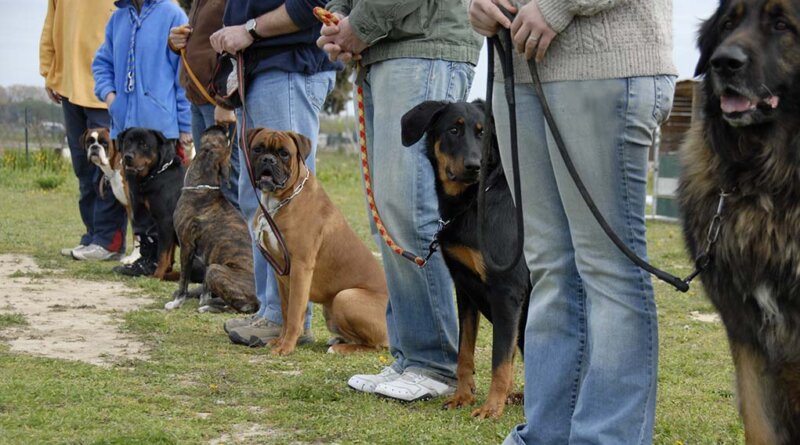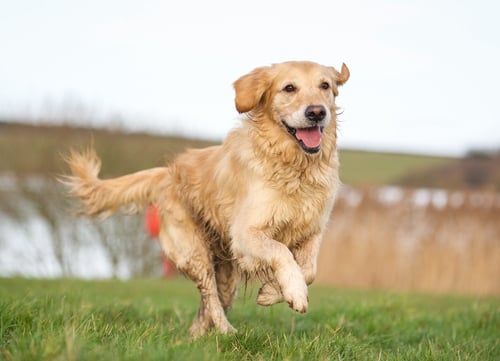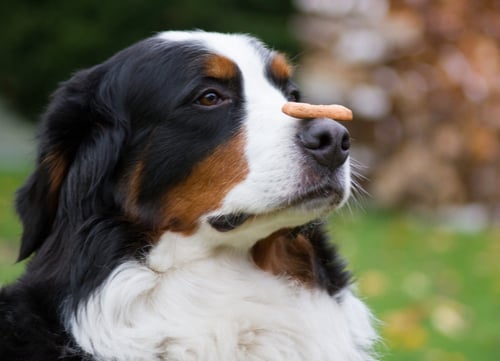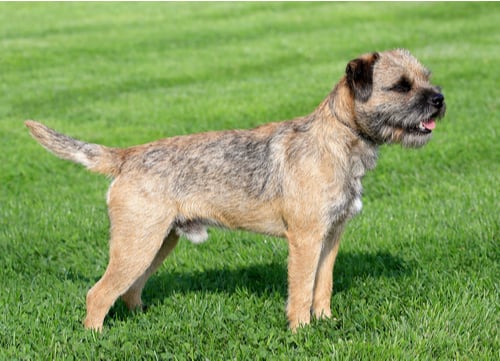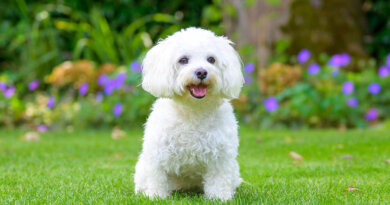19 Easiest Dog Breeds to Train And Where They Shine
Anyone who has ever owned a dog knows how difficult some dogs can be to train. And a dog that is difficult to train can become a dog that doesn’t make a great pet. But it isn’t always the dog’s fault. Whether it is basic housebreaking or more advanced tricks, even dogs who are easy to train require a commitment from their owner. You can’t start training a dog, stop and then start up again. Dog training requires consistency and patience. However, some dogs are easier to train than others.
A dog’s trainability involves a variety of factors. Their intelligence is one of them. But so are their breed, personality, genes and instincts. For example, a dog with a strong prey instinct might find it impossible to focus on learning a command when there are squirrels running around nearby. And a dog that is scent-driven might prefer to follow a scent than use its hearing to listen to your commands.
Additionally, the training methods you use for a dog of one breed might not work for another breed. Some dogs are more food-driven, while others are more driven by affection and praise as rewards. With so many different dog breeds on the planet, all bred for different purposes, it’s no wonder that some are easier to train than others.
Keeping all those factors in mind, here are 20 of the easiest dog breeds to train.
1. Poodle
Depending on who you ask, Poodles are widely agreed to be the second smartest breed in the world. This adds to their ease of training. However, it is vital that training and socializing occur early in their life. Without it, they can be very anxious and take part in undesirable behaviors.
Due to their intelligence, poodles need regular mental stimulation. Problem-solving toys are also great for Poodles, as they challenge their intelligence and keep them engaged mentally. They thoroughly enjoy obedience trials, agility work, hunting and tracking. In the absence of such activities, they should be provided lots of opportunities for regular exercise. Without exercise, they’re prone to obesity and may become destructive.
Poodles are a highly popular breed for designer dogs and mixed breeds. Many breeders combine Poodles with other breeds due to the fact that Poodles don’t shed. Goldendoodles, for example, have the traits of the Poodle and the Golden Retriever, but without the shedding that Goldens do. Anything that ends in “-oodle” or “-poo” is a mixed breed that is half Poodle.
2. Golden Retriever
Golden Retrievers are some of the most popular dogs in the United States, for a wide variety of reasons. They make great family dogs, even for new dog owners without prior dog experience. They’re incredibly eager to please, especially when motivated by food rewards. They’re also very intelligent but balance their intelligence with a childlike personality that makes them seem like puppies well into adulthood.
Despite their playful nature, Golden Retrievers can be serious when working. They enjoy hunting and field work, and they also make great guide dogs. To get the best out of your Golden Retriever and provide an environment that promotes trainability, be sure to provide them lots of opportunities for exercise and lots of companionship. They do well with kids and other animals as well if socialized at an early age.
3. Bernese Mountain Dog
The Bernese Mountain Dog is a large, fluffy working dog that’s considered a gentle giant. It loves outdoor activities, providing the weather isn’t too warm. It responds well to training, providing the trainer uses positive techniques. Punishing the dog instead of rewarding it will have an adverse effect on the Bernese Mountain Dog and make them less interested in learning new skills and tricks. They’re very eager to please, so feeling as if they disappointed you will make them feel discouraged, and training won’t be fun for them any more.
Considering their size (up to 26 inches or more at the shoulder and weighing an average of 90 pounds), it is important that Bernese Mountain Dog owners ensure their dog knows who the pack leader is. Training should start early to make it easier for the dog to realize this.
4. Border Collie
Border Collies are incredibly intelligent and have the energy to match. They are so energetic, in fact, that they need an owner who matches their energy level. Anyone looking for a lap dog will not get one in a Border Collie. You’ll have to live an active lifestyle with your Border Collie to ensure you live in harmony together. Besides obedience training, some of the activities to consider including in your day-to-day adventures should be agility training, herding and tracking so they can learn new mental skills while getting the vigorous activity they desperately need. They tend to be workaholics and enjoy filling their day with activities and snuggling up to their owner in the evening to relax.
5. Border Terrier
Not to be confused with the Border Collie, the Border Terrier may seem like it has a split personality. When it is working or preoccupied with a task, it is aloof and independent. But when hanging out at home with its family, it is affectionate and well-tempered. They are intelligent and trainable, providing you heed to their sensitive nature. Like other dogs on this list, they don’t take well to shouting or harsh punishment. Positive reinforcement is key. Patience and understanding are also needed. As a terrier, it has a strong urge to chase other small animals, so expecting them to learn new tricks when there are distractions around won’t do.
6. Havanese
Part of the toy group, the Havanese is a real people pleaser. It is also the national dog of Cuba. Havanese are considered to be natural clowns who love learning new tricks. Being the center of attention is typically a treat in itself when rewarding the Havanese for learning a new trick, although treats always help.
Due to their innate desire to please their humans, it is important that they have lots of companionship and regular socialization starting at an early age. A happy Havanese is a smart, easy dog to train, as long as you use positive methods. They’re generally sensitive and don’t respond well to harsh commands. Although they’re easy to train, being a toy breed means they’re not as easy to housetrain as other dogs might be. Still, some effective crate training and a lot of patience can help ensure they don’t have too many accidents as they’re learning.
7. Miniature Schnauzer
Miniature Schnauzers are the most popular of the three Schnauzer varieties — the other two being Giant Schnauzers and Standard Schnauzers. For the Miniature Schnauzer, learning new tricks and commands is a piece of cake. They crave the companionship of humans and are happy learning new tricks with you as long as they’re doing something with you instead of alone. They can become bored easily, so you’ll want to be sure you have lots of tricks up your sleeve to teach them when they need more mental stimulation. They’re also good at canine sports, whether it’s agility sports, rallying or earthdog events where they have to follow scents through tunnels.
Obedience training from an early age is important, especially in order to curb their barking tendencies. With proper training and mental stimulation, the Miniature Schnauzer can make a great companion.
8. Boxer
The handsome Boxer is a very friendly dog known for being exceptionally patient with children. A Boxer who has a strong bond with his family tends to be a happy dog, especially if his family takes the time to teach him new tricks and commands. They love mental and physical challenges and are very successful at performance events. But their intelligence can also make them stubborn, so they need an owner who is patient and persistent. They’re quite sensitive as well, so positive reinforcement is key.
One thing you should quickly train your boxer is the command, “Down.” That’s because they can become so easily excited when greeting humans that they jump and leap around.
9. Doberman Pinscher
Doberman Pinschers are very intelligent dogs. They’re so intelligent, in fact, that they are trainable at a very young age. They should be enrolled in puppy socialization and obedience classes by the type they’re 10 weeks old, if the trainer allows it. Typically, trainers prefer a dog who is a minimum of 6 months old, but waiting this long will risk them becoming too stubborn, willful and headstrong.
Dobermans are best suited for experienced dog owners who are able to show that they are the pack leader and provide consistent training. Without balance in their life, they can become aggressive and destructive. Boredom and loneliness are not friends to the Doberman Pinscher. If you are considering owning a Doberman Pinscher, it is a good idea to put all their pent up energy to good use as a therapy dog, or for search and rescue efforts.
10. German Shepherd
German Shepherds have lots of great qualities that, when combined, make them highly trainable dogs. First, they’re incredibly eager to please. Second, they love having a job to do. Third, they’re very active and thrive on mental and physical stimulation. Forth, they have an uncanny ability to learn and retain the commands you teach them.
Like the Doberman Pinscher, German Sheppards should start training as early as 8 weeks old. Start simple with basic commands. They should be able to come when called their name at an early age as well. As they get older, they will love agility training as well as regularly playing games of fetch outside.
A German Shepherd’s owner should be able to show they are the pack leader from an early age. If not, the German Sheperd will take the dominant role and become difficult to socialize and train.
11. Pembroke Welsh Corgi
The Pembroke Welsh Corgi is highly intelligent, energetic and willing to please, making them a great candidate for training. They are sensitive, however, meaning positive reinforcement for tasks that they do correctly is more important than scolding them for a task they do wrong. They love having a job to do, which can be beneficial. One of those jobs is herding, so you might find them running circles around you if they’re bored. They can also become bossy if you don’t show them you’re in charge.
The Pembroke Welsh Corgi is also known for being the favorite breed of Queen Elizabeth, II. They can make great pets for the right family.
12. Labrador Retriever
Another much-loved breed in the United States is the Labrador Retriever. In fact, it is the most popular dog in the country for several reasons. They’re incredibly easy to train and adapt well to life as a working dog, a family dog or both. They’re also laid back around family members and other animals, rarely if ever showing an aggressive nature. They do, however, require lots of exercise.
As for the exercise, keep in mind that they were originally bred to retrieve fishing nets for fishermen. This was, in part, due to their webbed feet and strong necks. They’re great swimmers, and their double coat helps them stay warm even in cold water. Without access to a swimming area, regular walks and some hard-core games of fetch should make your dog happy. He’ll be even happier with a job to do, however. Besides being great hunting companions, they make great therapy dogs as well. Without regular activity in their life, they can become destructive and anxious.
13. Australian Shepherd
The Australian Shepherd, also called an Aussie, has the ability to learn whatever you teach it, as long as you keep it entertained. Since it is so intelligent, it can become bored with the same old tricks. It’s strong work drive adds to its trainability, and it will often master new tricks much sooner than you anticipated.
In order to train and housebreak an Aussie puppy effectively, you’ll need a way to channel its energy. As such, they need between 30 to 60 minutes of exercise daily. They have a very strong herding drive, which may translate to an urge to control other animals and children the home. But you can use that drive and their high energy to let them compete in a variety of canine events. Alternatively, they love hiking and running as well.
14. Norwich Terrier
The Norwich Terrier is one of the smallest working dog breeds. They are very energetic for little dogs and need lots of opportunities for exercise in order to be happy. Although they’re fun and happy-go-lucky, they’re also very fearless and brave. This is an interesting sight considering they only reach 10 inches at the shoulder and weigh a small average of 10 pounds.
Norwich Terriers are notoriously easy to train, due to their intelligence and willingness to please. They excel in a variety of canine activities that include obedience, agility and earthdog events. With small bursts of exercise during the day and a chance to learn new tricks, the dog will be happy curled up in its human’s lap in the evening. It is important to keep training sessions short, however, as they can be stubborn and lose interest. Positive reinforcement is also key.
15. Papillon
The Papillon is often considered the most trainable and obedient of all toy breeds put together. Their intelligence and curiosity play large roles in their trainability, as does their immense desire to please their owners. They need a strong bond with their owner though. With an owner who fails to provide positive reinforcement and lacks dedication, training won’t be as easy.
Papillons are famously tough competitors in agility competitions. They absolutely love learning new ways to please their owner, so be prepared for lots of mental and physical stimulation if you’re considering a Papillon as a pet.
16. Brussels Griffon
Despite being considered a high-maintenance dog, the Brussels Griffon is one of the easiest dogs to train. There is one exception to that, however, and that is when it comes to housebreaking. But that is typical of any toy breed.
The Brussels Griffon is a very well-rounded breed, getting along well with other pets and children. But they tend to crave human companionship more than other breeds and don’t like to be left alone. They’re known for their cute faces, long beards and their ability to charm in the show ring. They’re also great at obedience, rally trials and agility.
17. Rottweiler
There is a reason why Rottweilers are commonly used as police dogs; they’re workers who thrive on having a job to do. Additionally, they are intelligent and strong. But they’re also devoted family dogs, providing they’re trained and socialized early. Without training, socialization, exercise and mental stimulation, Rotties can become destructive. They can also be territorial. Therefore you need to assert your dominance over the Rottweiler from an early age.
It is also important to be careful when playing with a Rottweiler. It may be natural to roughhouse with this sturdy breed, but that teaches them that rough play is acceptable at all times. They don’t know when rough is too rough. That can be dangerous when small kids are around and the Rottie wants to play. Getting kids involved with training activities, however, is a great way for the Rottie to learn that the human is the boss of the house while also promoting bonding with its family.
18. Shetland Sheepdog
Also known as a Sheltie, the Shetland sheepdog is a popular charmer in agility sports. They have a rich herding heritage and are very eager to learn new skills. They also love to please their owners and provide them with affection. The Shetland Sheepdog should be provided lots of opportunities for task-based exercises in order to be happiest.
It is important with a Sheltie to train them at an early age so they don’t cave into their herding tendencies. They’re known to chase anything that moves, so a fenced-in yard is ideal. Additionally, they’re known to be barkers. Rewarding them for not barking is a good way to prevent them from making it a regular occurrence.
19. English Springer Spaniel
English Springer Spaniels love the company of their human owners. Without it, they can become depressed and destructive. This is because they were bred to work long days in the field, hunting with humans. They’re natural people pleasers and very easy to train.
English Springer Spaniels need early socialization and obedience training to ensure they learn to be good companions. That includes making sure the owner shows they are in control at all times. Without consistent but gentle guidance, the Springer Spaniel might be tempted to fulfill its needs to explore and roam free. They’re active dogs that need regular exercise in order to prevent unwanted behavior. They also don’t like being alone for long periods of time either. Still, they make great pets for active families who don’t mind a dog tagging along on their adventures.
Conclusion
It is important to know that there are plenty of other dogs that might be easy to train, even if they aren’t on this list. These, however, have a reputation for trainability. Similarly, just because a dog is on this list doesn’t guarantee that they will be easy to train. Each dog is unique in its own way.

